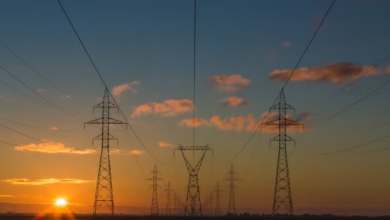Powering Tomorrow: Navigating the Shift to Renewable Energy and Its Economic Implications

As the world grapples with the urgent need to combat climate change and transition to sustainable energy sources, renewable energy is taking center stage in global discussions. The rise of solar, wind, and hydrogen power represents not only a shift in how we generate electricity but also a broader transformation of the energy landscape. Governments across the globe are implementing a variety of incentives and strategies to accelerate this transition, recognizing the critical role that clean energy plays in achieving environmental goals. However, the journey towards a fully sustainable energy system is fraught with challenges, particularly in energy storage and the evolving role of nuclear power in a low-carbon future. Meanwhile, traditional oil and gas companies are adapting to the changing market dynamics, while electric vehicles emerge as a key player in reducing fossil fuel dependency. As energy prices fluctuate due to geopolitical and economic factors, the focus on energy efficiency innovations becomes increasingly relevant, with significant potential for cost savings. This article delves into these interconnected themes, exploring the current landscape and future possibilities of renewable energy and its impact on our society and economy.
- 1. **Harnessing Nature: The Growth of Solar, Wind, and Hydrogen Power**
- 2. **Incentives and Innovations: Government Strategies for a Clean Energy Transition**
1. **Harnessing Nature: The Growth of Solar, Wind, and Hydrogen Power**
The transition to renewable energy sources has gained significant momentum in recent years, driven by advancements in technology, decreasing costs, and a growing awareness of the urgent need to address climate change. Solar, wind, and hydrogen power have emerged as key components in this shift, each harnessing natural resources to provide sustainable energy solutions.
Solar power has become one of the fastest-growing energy sources globally. Photovoltaic (PV) technology has improved dramatically, leading to higher efficiency rates and lower installation costs. Governments worldwide are promoting solar energy through subsidies, tax incentives, and renewable portfolio standards, encouraging both residential and commercial adoption. Large-scale solar farms are increasingly prevalent, contributing to grid stability and energy diversification.
Wind energy has similarly seen unprecedented growth, with onshore and offshore wind farms becoming essential contributors to many countries' energy mixes. Technological advancements in turbine design and placement have significantly increased energy production capacities. Governments support this transition by investing in infrastructure, providing financial incentives, and enacting policies that promote the expansion of wind energy projects.
Hydrogen power is emerging as a versatile and clean energy carrier. It can be produced through various methods, including electrolysis powered by renewable energy sources, making it an attractive option for decarbonizing sectors that are difficult to electrify, such as heavy industry and transportation. The development of hydrogen infrastructure, including production, storage, and distribution systems, is crucial for its widespread adoption. Governments are recognizing hydrogen's potential and are beginning to invest in research, development, and pilot projects to foster innovation and scalability.
Together, solar, wind, and hydrogen power represent a comprehensive approach to harnessing nature's resources for a sustainable energy future. Their growth is not only essential for reducing greenhouse gas emissions but also for creating jobs, enhancing energy security, and fostering economic resilience in the face of climate change. As these technologies continue to evolve and integrate into existing energy systems, they will play a pivotal role in shaping a cleaner, more sustainable world.
The transition to renewable energy sources such as solar, wind, and hydrogen power is being fueled by a combination of government incentives, technological advancements, and societal demand for cleaner energy. Governments worldwide are implementing policies to encourage this shift, including tax credits, subsidies for renewable projects, and investment in research and development. These incentives aim to lower the cost of renewable technologies and make them more competitive with fossil fuels.
However, one of the major challenges facing the widespread adoption of renewable energy is energy storage. Unlike traditional energy sources, renewables are intermittent; solar and wind energy production can fluctuate based on weather conditions and time of day. As a result, effective energy storage solutions are crucial to ensure a reliable energy supply. Technologies such as batteries and pumped hydro storage are being developed and improved, but scaling these solutions to meet growing energy demands remains a significant hurdle.
In parallel, the role of nuclear energy in a low-carbon future is gaining renewed attention. Nuclear power produces minimal greenhouse gas emissions and can provide a stable source of energy that complements intermittent renewables. However, concerns regarding safety, waste disposal, and public perception continue to challenge its expansion.
As the energy landscape evolves, traditional oil and gas companies are also adapting by diversifying their portfolios. Many are investing in renewable energy projects, carbon capture technologies, and electric vehicle infrastructure to align with the global shift towards sustainability.
Electric vehicles (EVs) play a critical role in reducing dependency on fossil fuels. As battery technology improves and charging infrastructure expands, EVs are becoming more accessible to consumers, further driving down emissions in the transportation sector.
The economic impact of energy price fluctuations is another vital consideration. Volatile fossil fuel prices can lead to uncertainty in energy markets, affecting everything from household budgets to global trade. In contrast, renewable energy sources often have lower operating costs once established, providing a more stable long-term economic outlook.
Finally, innovations in energy efficiency are transforming how energy is consumed across various sectors. From smart home technologies to industrial processes, these advancements promise significant cost savings and reduced energy consumption, contributing to a more sustainable future. Overall, the convergence of these factors presents both opportunities and challenges in the transition to a cleaner energy landscape.
2. **Incentives and Innovations: Government Strategies for a Clean Energy Transition**
Governments worldwide are increasingly recognizing the imperative of transitioning to clean energy sources to combat climate change and ensure energy security. To facilitate this shift, many are implementing a range of incentives and innovative strategies designed to promote the adoption of renewable energy technologies.
One of the primary ways governments incentivize clean energy is through financial mechanisms such as tax credits, grants, and subsidies. These financial incentives reduce the upfront costs associated with installing renewable energy systems, making solar panels, wind turbines, and hydrogen production more accessible to both businesses and consumers. For instance, in the United States, the Investment Tax Credit (ITC) allows homeowners and businesses to deduct a significant percentage of the installation costs of solar systems from their federal taxes. Similarly, various countries offer feed-in tariffs, ensuring fixed payments for renewable energy producers, encouraging investment in green technologies.
In addition to financial support, governments are also employing regulatory measures to stimulate clean energy adoption. Renewable portfolio standards (RPS), for example, require utility companies to obtain a certain percentage of their energy from renewable sources. This creates a guaranteed market for renewable energy and drives innovation as utilities seek to meet these mandates. Moreover, streamlined permitting processes and favorable zoning laws can expedite the deployment of renewable energy projects, further enhancing their attractiveness.
Innovations in technology also play a critical role in the clean energy transition. Governments are investing in research and development to advance energy storage solutions, smart grid technologies, and carbon capture methods, which are essential for integrating renewables into the existing energy infrastructure. Collaborative initiatives between public institutions and private companies foster innovation, leading to breakthroughs that can drive down costs and improve efficiency.
Public awareness campaigns and educational programs are also vital components of government strategies. By informing citizens about the benefits of renewable energy and energy efficiency, governments can cultivate a culture of sustainability and encourage individual action, such as adopting electric vehicles or improving home energy efficiency.
Ultimately, the combined efforts of financial incentives, regulatory frameworks, technological innovation, and public engagement are creating a conducive environment for the transition to clean energy. As governments continue to refine these strategies, the global energy landscape is poised for significant transformation, paving the way toward a sustainable and resilient energy future.
In conclusion, the transition to renewable energy sources like solar, wind, and hydrogen power represents a pivotal shift in our approach to addressing climate change and fostering sustainable development. Government incentives play a crucial role in facilitating this transition, providing the necessary support for innovations that drive down costs and enhance efficiency. However, challenges such as energy storage and the future of nuclear energy remain critical considerations that must be addressed to create a reliable and resilient energy infrastructure.
As oil and gas companies adapt to this evolving landscape, they are embracing new technologies and business models that align with the global push for cleaner energy solutions. The integration of electric vehicles further underscores the commitment to reducing fossil fuel dependency and promoting greener transportation options. Additionally, fluctuations in energy prices highlight the need for economic strategies that bolster stability and protect consumers, while innovations in energy efficiency promise significant cost savings and environmental benefits.
Looking ahead, the collective efforts of governments, industries, and individuals will be essential in navigating the complexities of the energy transition. The path toward a sustainable energy future is not without its challenges, but it also presents unparalleled opportunities for innovation, economic growth, and environmental stewardship. With continued commitment and collaboration, we can harness the potential of renewable energy to create a cleaner, more sustainable world for generations to come.





